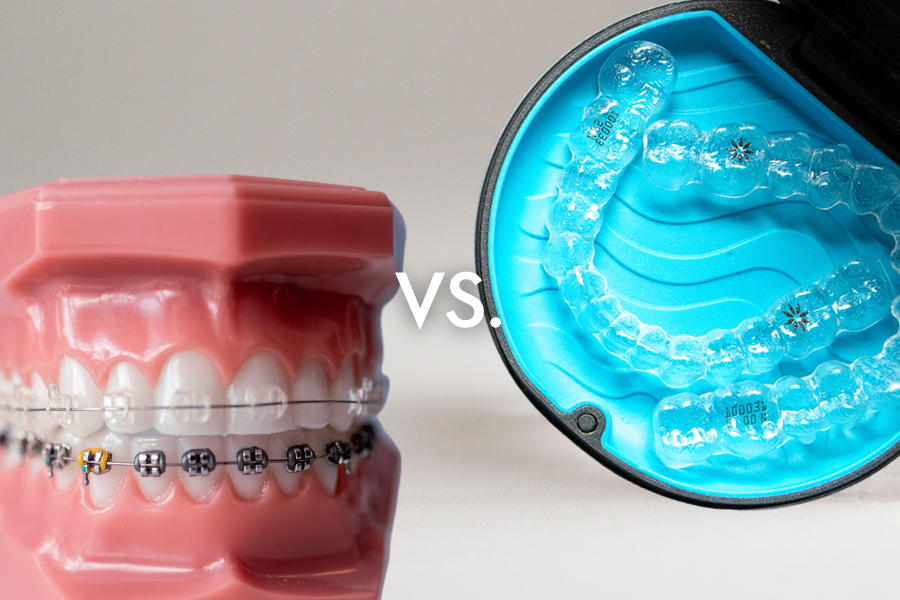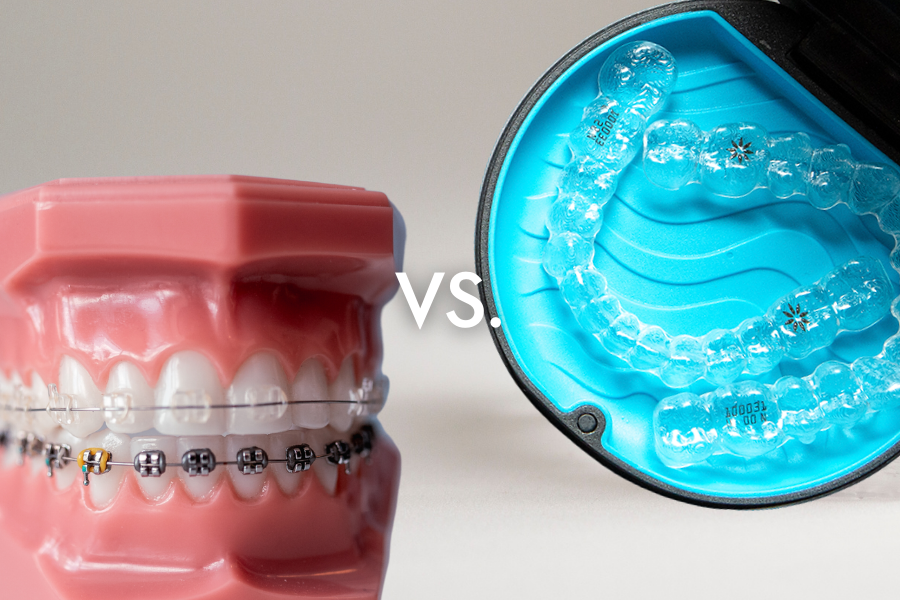
Looking for a more confident smile? For those of us with crooked teeth, overbite, underbite, and other teeth misalignment issues, it can be challenging to settle on the right treatment.
Invisalign® is an option that uses a series of clear aligners and SmartForce attachments which serve as handles. Those give the aligners something to push on. On the other hand, braces use a series of metal brackets, ligature elastics, and wires. Both treatments move teeth with the right amount of force, to straighten them out..png?width=900&name=Invisalign%20vs%20Braces%20(3).png)
Invisalign vs. Braces
What are the pluses and minuses of each? Aesthetically speaking, you can’t hide braces. The metal and wiring are there for all the world to see for the length of your treatment time.
The Invisalign custom-fit aligners are clear and plastic, virtually invisible. You’ll know you’re wearing Invisalign but the general public won’t. Ask a younger person who frequently posts on social media which option they would prefer.
There are also big differences when the topic of hygiene comes up. Invisalign has a lot of advantages in this area, says Dr. Yasmin Vakilian, Dentist at HealthOne.
“You can eat whatever you want, enjoy your food because they are removable,” she says. That’s not the case with braces. How many times have you heard complaints from people with braces, missing out on enjoying a full variety of food, like pizza, steak, corn on the cob, because of food getting stuck in their braces?
“With Invisalign, you can eat, floss, do everything as you would without having to have anything on your teeth,” Dr. Vakilian says. “I think that’s a big reason for the popularity.”
You’ll also have a harder time keeping your teeth clean with braces on. The fact that the Invisalign trays are removable means you can brush and floss your teeth properly. With young people especially, cavities will develop because of how difficult it is to keep teeth clean while wearing braces.
.png?width=900&name=Invisalign%20vs%20Braces%20(2).png)
Cost Differential
Cost is another big issue when people are weighing the pros and cons of going with Invisalign or braces. HealthOne will prioritize a payment plan with each patient, and base it on the patient’s financial reality. Some HealthOne patients will pay $120 per month, over 48-, 36- and 24-month periods.
Factors that determine cost include the amount of work needed to shift your teeth, the number of times you need to see the dentist, and how much your insurance plan covers orthodontics. “Price varies a lot depending on the complexity of treatment so it’s hard to say,” she says. “But for the most part braces cost more.”
What about treatment time? Braces are longer – 24-30 months, according to the patient’s needs. With Invisalign treatment, the period from initial consultation to a better smile has been shortened considerably. With the custom digital-based treatment plan, combined with the experience the HealthOne team has worked with Invisalign, in most cases the period is boiled down to six months.
The biggest difference between braces and Invisalign though is the ease of use, and flexibility according to lifestyle. With the Invisalign treatment, you can properly enjoy a meal. If you’re playing a sport where the aligners might get in the way, just remove them. They are made of smooth plastics that have no rough edges so there’s no discomfort in the mouth. With braces, you’ll get wires poking the cheek or lips.
What Is the Best Age to Get Invisalign?
Dr. Vakilian says Invisalign can be started at any age as long as the adult teeth have fully erupted. In fact, there are special Invisalign aligners even for baby teeth. However, HealthOne only offers Invisalign treatment for their adult patients..png?width=900&name=Invisalign%20vs%20Braces%20(4).png)
Can I Not Wear Invisalign for a Day?
Both braces and Invisalign will help you achieve that Instagram-worthy smile. “The specific way the teeth are moved is different between the two,” Dr. Vakilian says. “Which option is best depends on the individual and the doctor’s recommendation. Although most complex cases can be realigned with Invisalign, sometimes the best option may be metal braces. A dentist can help you decide which option is best.”
At least with braces, the device is locked onto your teeth. It’s not impossible, but it is costly, to remove and re-install braces. With the Invisalign technology, the aligners are strong enough to slowly move the teeth over time, in small incremental movements.
But commitment is important – you have to wear the aligners for at least 20 hours a day to properly shift and rebuild the bones in the mouth. If someone is non-compliant, they won’t get the desired result
Bottom line: Invisalign is suitable for both young people and seniors, as well as adults. Teeth can move at any age. “As long as there is no periodontal disease and other contraindications to treatment,” she adds.
Invisalign Toronto
Having straight and beautiful teeth translates to a confident smile. The professionals at our clinic understand the importance of this and are fully experienced with one of the leading-edge orthodontic options in the industry right now.
The Invisalign Advantage Program has recognized HealthOne Dental as a Diamond Provider, meaning we are in the top one percent of Invisalign providers in North America.
One Life. Live Inspired.

